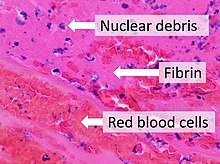
Back فبرين Arabic Фибрин Bulgarian ফাইব্রিন Bengali/Bangla Fibrin BS Fibrina Catalan فایبرین CKB Fibrin Czech Fibrin Danish Fibrin German Fibrina Spanish


Fibrin (also called Factor Ia) is a fibrous, non-globular protein involved in the clotting of blood. It is formed by the action of the protease thrombin on fibrinogen, which causes it to polymerize. The polymerized fibrin, together with platelets, forms a hemostatic plug or clot over a wound site.
When the lining of a blood vessel is broken, platelets are attracted, forming a platelet plug. These platelets have thrombin receptors on their surfaces that bind serum thrombin molecules,[1] which in turn convert soluble fibrinogen in the serum into fibrin at the wound site. Fibrin forms long strands of tough insoluble protein that are bound to the platelets. Factor XIII completes the cross-linking of fibrin so that it hardens and contracts. The cross-linked fibrin forms a mesh atop the platelet plug that completes the clot. Fibrin was discovered[2] by Marcello Malpighi in 1666.[3]
- ^ Kehrel BE (2003). "[Blood platelets: biochemistry and physiology]". Hamostaseologie (in German). 23 (4): 149–158. doi:10.1055/s-0037-1619592. PMID 14603379.
- ^ Arney, Kat (31 May 2017). "Fibrin and fibrinogen". Chemistry World. Cambridge, UK: Royal Society of Chemistry. Retrieved 25 November 2022.
- ^ "350th Anniversary of the Discovery of Fibrin (1666–2016) History of Fibrin(ogen)". IFRS. Winston-Salem: International Fibrinogen Research Society. 23 June 2016. Retrieved 25 November 2022.